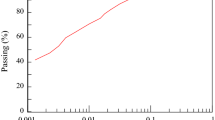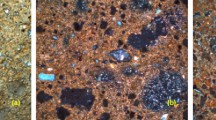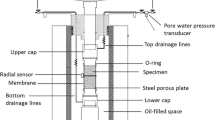Abstract
Clays treated with lower cement contents often exhibit behaviour similar to stiff clays with planar failure surface under triaxial compression. In the present work the behaviour of a marine clay treated with 5 % cement, subjected to undrained triaxial compression tests is studied. The pre-consolidation pressure of the cemented clay due to the cementation bonding is observed to be very high. It is attempted to model the behaviour of cement treated clay using a bounding surface plasticity formulation as the plastic behaviour of the cemented clays within the yield surface has to be considered. The effect of cementation is included in the model as the pre-consolidation pressure obtained from consolidation tests. The tensile strength due to cementation bonds is included in the equation of the bounding surface. Simulations of the undrained triaxial compression tests on cemented clays are carried out and the results are validated with the experimental results.





Similar content being viewed by others
References
Al-Tabbaa A, Wood MD (1989) An experimentally based bubble model for clay. In: Proceedings of numerical models in geomechanics NUMOG 3, Elsevier Applied Science: London, 91–99
Anandarajah A, Dafalias YF (1986) Bounding surface plasticity. 3: application to anisotropic cohesive soils. J Eng Mech 112(12):1292–1318
Bergado DT, Ruenkrairergsa T, Taesiri Y, Balasubramaniam AS (1999) Deep soil mixing to reduce embankment settlement. Ground Improv J 3(3):1–18
Boone SJ (1996) Factors affecting at-rest lateral stress in artificially cemented sands: discussion. Can Geotech J 33(2):371–372
Bushra I (2011) Compressibility and strength characteristics of marine soil treated with cement and fly ash. PhD thesis, Indian Institute of Technology Madras, Chennai, India
Dafalias YF (1986) Bounding surface plasticity. 1: mathematical foundation and hypoplasticity. J Eng Mech 112(9):966–987
Dafalias YF, Herrmann LR (1982) Bounding surface formulation of plasticity. In: Pande GN, Zienkiewicz OC (eds) Soil mechanics—transient and cyclic loads, pp 219–252
Dafalias YF, Herrmann LR (1986) Bounding surface plasticity. 2: application to isotropic cohesive soils. J Eng Mech 112(12):1263–1291
Dafalias YF, Popov EP (1975) A model of nonlinearly hardening materials for complex loading. Acta Mech 21:173–192
Head KH (1998) Manual of soil laboratory testing, volume 3: effective stress tests. Wiley, Singapore
Horpibulsuk S, Liu MD, Liyanapathirana DS, Suebsuk J (2010) Behaviour of cemented clay simulated via the theoretical framework of the structured cam clay model. Comp Geotech 37:1–9
Kassim KA, Clarke BG (1999) Constant rate of strain consolidation equipment and procedure for stabilized soils. Geotech Test J 22:13–21
Khong CD (2004) Development of numerical evaluation of unified critical state models. PhD Thesis, University of Nottingham, UK
Krieg RD (1975) A practical two surface plasticity theory. J Appl Mech 42:641–646
Lee K, Chan D, Lam K (2004) Constitutive model for cement treated clay in a critical state frame work. Soils Found 44(3):69–77
Liu MD, Carter JP (2002) A structured Cam clay model. Can Geotech J 39:1313–1332
McClintock FA, Walsh JB (1962) Friction on Griffith’s crack on rocks under pressure. In: Proceedings of the fourth US congress on applied mechanics, Berkeley, CA
Mroz Z, Norris VA, Zienkiewicz OC (1979) Application of an anisotropic hardening model in the analysis of elastoplastic deformation of soils. Geotechnique 29:1–34
Muhunthan B, Masad E (1997) Fabric effects on stress-strain behavior of clays. In: Proceedings of the sixth international symposium on plasticity and its current applications. Juneau, Alaska
Muhunthan B, Sariosseiri F (2008) Interpretation of geotechnical properties of cement treated soils. Research report, FHWA Contract DTFH 61-05-C-00008
Rouania M, Wood MD (2000) A kinematic hardening constitutive model for natural clays with loss of structure. Geotechnique 50(2):153–164
Smith RE, Wahls HE (1969) Consolidation under constant rates of strain. J Soil Mech Found Div 95(2):519–539
Suebsook J, Horpibulsuk S, Liu M D (2007) Simulation of the undrained shear behavior of induced cemented clay with a cemented soil model. In: Proceedings PSU-UNS International Conference on Engineering and Environment, Phuket, Thailand
Zhu F, Clark JI, Paulin MJ (1995) Factors affecting at-rest lateral stress in artificially cemented sands. Can Geotech J 32:195–203
Author information
Authors and Affiliations
Corresponding author
Rights and permissions
About this article
Cite this article
Pillai, R.J., Bushra, I. & Robinson, R.G. Undrained Triaxial Behavior of Cement Treated Marine Clay. Geotech Geol Eng 31, 801–808 (2013). https://doi.org/10.1007/s10706-012-9605-3
Received:
Accepted:
Published:
Issue Date:
DOI: https://doi.org/10.1007/s10706-012-9605-3




